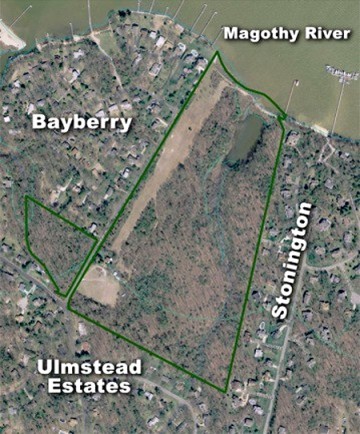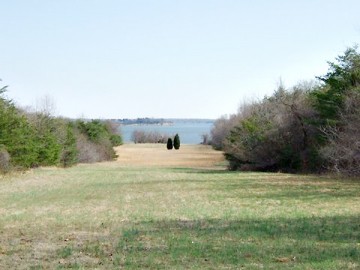Last Farm on the Magothy
There aren’t many farms left once you head north from Annapolis. The Spriggs Farm on the Magothy River is part of a dying breed. With its sweeping views of Dobbins Island and bird-draped, saltwater tidal pond, it’s a one-of-a-kind place. According to legend, Ulmstead Point, its promontory, was the site of feasts between the Indian tribes of western Maryland and Gibson’s Island.
Touring the farm with Jack Neil, trustee of Spriggs Farm Preservation Foundation, a group of neighbors organized to save the property, I was amazed to discover an untouched gem amid the suburban sprawl of the bustling Broadneck Peninsula.
Rise and Fall of a Farm
In the 1870s, James Spriggs owned 400 acres of prime forest and farmland along the Magothy River, comprising Ulmstead Point and the rolling hills to the north and west.
Today, only 55 acres of Spriggs’ 400 remain. The rest was sold years ago for the upscale communities of Bayberry and Ulmstead Estates, where spacious homes have replaced farm fields.
I remember going with my mother to the nearby Ulmstead Farm when I was a little boy. I can still see the shiny white farm silo rising into the sky like a rocket ship while fat dairy cows grazed in the surrounding fields. Even in the early 1960s, before our local farms started sprouting mansions, this was a world apart. Forgotten memories and the smells of lost dreams filled my head as I drove up the dirt road to the wooden farmhouse many years later.

As we walked toward the river, crickets exploding from the grass, Jack recounted the property’s rich history. Like much of America, its history is written in property deeds.
In 1880, Spriggs gave his daughter Ruth 101 acres in the Bayberry area along the Magothy River when she married Frank Baldwin. Fifteen years later, the Spriggs-Baldwin property was purchased by a man named Randall, who sold it in 1909 to Baltimorean Henry Stainback and his wife Nora. Charles Barnard Lynch bought 46 acres of the tract in 1927. The Spriggs’ name was reclaimed in 1929, when Stainback’s daughter Ruth married Franklin Spriggs and became the second Ruth Spriggs to live on the farm.
Ruth and Franklin farmed the property until his death in 1982. Watermelons and tomatoes were among their crops, transported from the farm to Annapolis and Baltimore on large, flat-bottomed boats called bugeyes.
The property went on the chopping block again when Ruth Spriggs died in 2008 at 100.
Trying for a Future
Land appraisers are busy trying to determine the fair-market value of the last farm on the Magothy, with 650 feet of undeveloped shoreline along the southern shore of the river. A recent natural resources inventory of 14,000 parcels in Anne Arundel County listed the farm as the 18th most significant property based on its watershed protection value.
When the property went up for sale, neighbors banded together to form the Spriggs Farm Preservation Foundation. In a workshop, citizens of Stonington, Ulmstead and Bayberry hammered out their objectives. They envision walking trails and an outdoor classroom where folks can step back in time and learn about their disappearing past.
But how? Where are they going to find millions of dollars to save the farm? Several developers have already approached the family estate, and back taxes still have to be paid. The clock is ticking.
The Spriggs Farm Preservation Foundation has an ambitious plan, piecing together a myriad of government funding sources during a time when money is very tight. Anne Arundel County supports the purchase in two ways, with $1 million from the Forest Conservation Fund plus funds from its local land preservation program. Maryland Department of Natural Resources is applying for a $700,000 grant from the Land and Water Conservation Fund.
State and county funding may make or break the deal. Both are bound by strict purchasing laws to pay the average of three appraisals. With no wiggle room, preservationists and their government partners will try to get to that magic average. Then the Spriggs estate decides which offer to accept.

Past Meets Future
From the shores of the wind-whipped Magothy, I walked far out into the shallow river so I could look back at the property from the water. It was not hard to imagine Indians roasting oysters and clams over a roaring fire from atop the high, sandy banks. I could see fields of ripe melons stretching up the gently sloping hill to the towering old farmhouse on the hill. I could hear the barking orders of the ship captains as they loaded their boats with fresh vegetables. The past came alive.
When I asked Jack why he was volunteering so much of his time to save a piece of forgotten land, he said his young son had pushed him into action.
“My son reminded me of the old adage that it is better to know by trying, and that in the end the real lesson here is that we all need to be good stewards of the land.”
